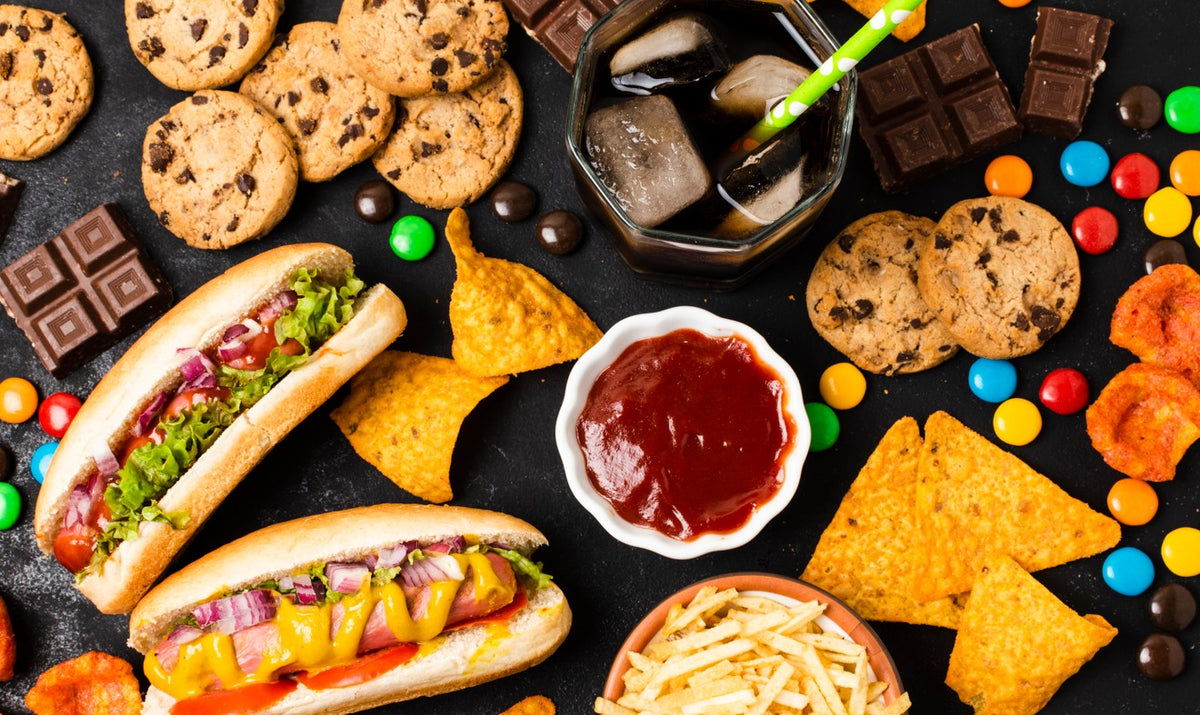

Food has long been categorised by type, nutritional content and flavour profile. But there’s a new(ish) category in town that’s got everyone talking, and it’s all to do with how our food is processed.
Table of Contents
What Is Ultra-Processed Food?

Ultra-processed food, or UPF for short, is heavily manufactured and/or modified food that’s loaded with additives, emulsifiers and artificial flavours. This tends to include all those snacks we end up reaching for after a long day - those convenient, delicious treats that leave us craving more (and more…).
UPFs have been getting serious air-time lately. First came physician and TV presenter Dr Chris van Tulleken’s 2023 book, Ultra-Processed People, which exposed food producers and the tricks they use to make consumers addicted to UPFs. Then just last week, Dr Chris joined forces with the nation’s fave fitness coach, Joe Wicks, for the Licensed To Kill documentary, uncovering all the nasties hidden in protein bars marketed to us as ‘healthy’.
Should We Avoid UPFs?
Whilst UPFs have received bad press, the advice isn’t to avoid them altogether. It’s not that black and white (is it ever?). And in fact, some UPFs can play an important role in a healthy and balanced diet - so long as you’re savvy about which foods to include, and which to avoid.
So, if you’re feeling miffed about UPF, this blog series aims to shed light on the subject by exploring:
What UPF is
UPF examples
The potential risks
Why not all UPFs are created equal
Some healthy UPF swaps
How to combat potential UPF side effects

How Is UPF Classified?
“Ultra-processed food” is a term coined by researchers from the University of Sao Paulo in Brazil, when they created the NOVA food classification system. It orders food into four groups:
1. Unprocessed or minimally processed- food that hasn’t been changed much (or at all) from its original state, including things like fruit, vegetables, eggs, seeds and nuts.
2. Processed culinary ingredients - food added to other food, such as sugar, salt, butter and oils
3. Processed- food created by combining foods from the above groups, for instance freshly made bread, tinned fruit and veg, tinned fish and cheese
The fourth group is (you guessed it) ultra-processed foods, which tend to share a number of characteristics:
5+ ingredients
Wholly altered from their original state
Contain ingredients you wouldn’t find in your kitchen cupboard - such as preservatives, emulsifiers and artificial colours
What Are Some Common UPFs?
Ever looked at the back of a label to discover an ingredients list as long as your arm? Chances are, that food was ultra-processed. In fact, UPFs include many of our favourite cupboard staples, such as:
Packaged cakes and biscuits
Sweets and chocolate
Some ready meals
Crisps
Sweetened drinks
Packaged meat (like pasties and pies)
Supermarket bread
Breakfast cereals
Ice cream
Fruit-flavoured yogurts

What Are The Potential Risks Of UPF?
UPFs tend to be high in calories, salt or sugar, and saturated fats - and at the same time, low in fibre. They don’t usually have high nutritional value, so when we eat a lot of them, we’re not leaving much space in our diets left for healthier whole foods that contain more of the minerals and vitamins our bodies need to function at their very best.
Eating too many UPFs have been linked to a number of potential health conditions, including obesity, anxiety and depression, and even cancer. But there remains a question mark over exactly what it is about UPFs that can lead to these conditions - for instance, whether it’s what the foods contain, how they are processed, or a bit of both.
We can’t explicitly say that UPFs ‘cause’ these conditions, either. Studies simply show that people who consume a lot of UPFs can be at greater risk of developing certain health issues.

Not All UPFs Are Created Equal
There’s a lot of scaremongering around UPFs, but the truth is that certain processed foods can provide some nutritional benefits. Wholemeal breads and wholegrain breakfasts fortified with vitamins are just two examples.
This makes the NOVA classification system slightly ambiguous, as a Zoe blog rightly points out. It cites a study which found that UPFs can have both negative and positive effects on our health, for instance:
Artificially-sweetened drinks and processed meats lead to a higher risk of cardiovascular health, while cold cereals, bread and dairy-based desserts lowered the risk
Sweet spreads, condiments and artificially-sweetened drinks lead to a higher risk of diabetes, while cereals and packaged savoury snacks reduced the risk
This all supports what we said earlier: it’s not just a case of cutting out UPFs entirely. Rather, it’s about being conscious about the UPFs you consume, and how many, whilst ensuring the remainder of your diet is made up of nutritious whole foods packed with vitamins and minerals.
Supporting Your Health, Naturally
When it comes to hitting your nutritional targets, let our award-winning Multee multivitamin become your favourite ally. It’s loaded with 40 ingredients with an added dose of greens, and contains no nasty fillers or binders, making it 100% natural.
In the meantime, stay tuned for the next blog in our series, where we look at some simple, healthier swaps for common UPFs.

Note: This article is for informational purposes only and is not intended to be a substitute for professional medical advice, diagnosis, or treatment. Always seek the advice of your physician or other qualified health provider with any questions you may have regarding a medical condition.




